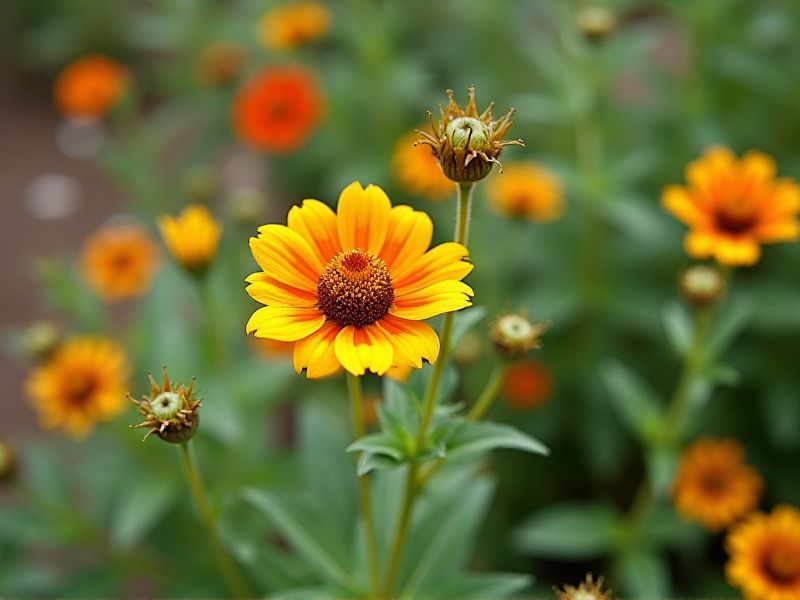
Drought-tolerant garden plants, such as succulents, lavender, and ornamental grasses, can thrive in arid conditions with minimal water. Agave and sedum are popular choices known for their ability to store moisture in their leaves, making them ideal for dry landscapes. Eco-friendly options like native wildflowers and Mediterranean herbs can enhance biodiversity while requiring less irrigation. When choosing plants, consider adding mulch to retain soil moisture and reduce evaporation. Incorporating these resilient species not only conserves water but also creates an aesthetically pleasing, low-maintenance garden.
List of some Garden plants that tolerate drought
- Lavender (Lavandula)
- Rosemary (Rosmarinus officinalis)
- Sage (Salvia officinalis)
- Yarrow (Achillea millefolium)
- Russian Sage (Perovskia atriplicifolia)
- Sedum (Sedum spp.)
- Agave (Agave spp.)
- Blanket Flower (Gaillardia)
- Coneflower (Echinacea)
- Kangaroo Paw (Anigozanthos)
Important things about Garden plants that tolerate drought
Succulents
Succulents are specialized garden plants celebrated for their ability to thrive in arid conditions, making them ideal for drought-prone areas. These water-storing plants, including popular varieties like Echeveria and Agave, feature thick, fleshy leaves that minimize water loss. You can enhance your garden's aesthetic by incorporating diverse succulents, which come in a range of shapes, sizes, and colors. Proper drainage is crucial for the success of these drought-tolerant plants, as it prevents root rot while allowing them to flourish with minimal water requirements.
Native Plants
Native drought-tolerant garden plants, such as lavender, sedum, and black-eyed Susans, thrive in arid conditions while providing vital support to local ecosystems. These resilient varieties minimize water usage and maintenance needs, making them ideal for sustainable landscaping. By incorporating native plants into your garden, you attract beneficial pollinators like bees and butterflies, promoting biodiversity in your outdoor space. Emphasizing native species preserves regional characteristics and contributes to a healthier environment, ensuring that your garden remains vibrant even in dry spells.
Perennials
Drought-tolerant perennials are essential for sustainable gardening, especially in arid climates. Varieties like Echinacea (Coneflower), Agastache (Hyssop), and Sedum (Stonecrop) thrive with minimal water, showcasing vibrant flowers and foliage. These resilient plants not only conserve water but also attract pollinators such as bees and butterflies to your garden. By incorporating drought-resistant perennials, you can achieve a beautiful landscape while promoting environmental sustainability.
Xeriscaping
Drought-tolerant plants are essential for xeriscaping, as they conserve water while creating vibrant landscapes. Succulents such as agave and sedum thrive in arid conditions, requiring minimal moisture and showcasing unique textures. Native grasses like blue fescue and tufts of lavender not only withstand dry spells but also attract pollinators, enhancing biodiversity in your garden. Incorporating these resilient species promotes sustainability and reduces maintenance, allowing you to enjoy a lush garden that flourishes even in challenging climates.
Deep Root Systems
Drought-tolerant garden plants often possess deep root systems that enable them to access moisture stored deep within the soil. Plants such as the Agave, with its robust, extensive roots, can thrive in arid conditions by absorbing water from underground reserves. Other examples include various species of native grasses and succulents, which have adapted to survive with minimal water by efficiently utilizing their deep intertwining roots. By selecting these resilient plants for your garden, you can create an eco-friendly landscape that conserves water while providing vibrant beauty.
Water-Efficient Irrigation
Drought-tolerant garden plants, such as succulents, lavender, and ornamental grasses, require significantly less water while still flourishing in sunny conditions. These plants have adapted various mechanisms, including deep root systems and water-storing capabilities, to survive prolonged dry periods, making them ideal choices for water-efficient irrigation practices. Incorporating mulching and drip irrigation systems can further enhance water retention in the soil, promoting healthier plant growth and reduced water waste. By selecting these resilient varieties, you can create a vibrant garden while conserving precious water resources.
Mulching
To enhance the resilience of drought-tolerant garden plants, applying mulch is essential for moisture retention. Organic mulches, such as bark chips, straw, or shredded leaves, not only conserve soil moisture but also improve soil structure as they decompose. Drought-tolerant plants like lavender, succulents, and ornamental grasses can thrive in these conditions, benefiting from the protective layer mulch provides against extreme temperatures. By implementing mulching techniques, you can create a sustainable garden that reduces water consumption while promoting healthy plant growth.
Soil Quality
Drought-tolerant garden plants thrive in well-draining, sandy or loamy soil, which allows for optimal root aeration and moisture retention. Improving soil quality with organic matter, such as compost, enhances nutrient availability and promotes beneficial microbial life, crucial for sustaining resilient plant growth. Choosing resilient species like succulents, lavender, and ornamental grasses can minimize water usage while adding beauty to your garden. To maintain soil health, mulching can reduce evaporation and mitigate temperature fluctuations, ensuring your drought-resistant plants flourish even in dry conditions.
Plant Selection Timing
Selecting drought-tolerant garden plants requires careful timing, ideally during the early spring or fall, as these seasons provide optimal conditions for root establishment. Species such as lavender, succulents, and ornamental grasses thrive in dry environments, making them excellent choices for water-efficient gardens. It's essential to prepare your soil in advance, incorporating organic matter that retains moisture while improving drainage. By planting during ideal seasons, you enhance the resilience of your garden against drought conditions, ensuring vibrant growth and sustainability.
Proper Maintenance
Drought-tolerant garden plants, such as succulents, lavender, and native grasses, require minimal watering once established, making them perfect for low-maintenance landscaping. To ensure their health, mulching around these plants can help retain soil moisture and regulate temperature, while also suppressing weeds that compete for resources. Regularly checking for pests and diseases, although infrequent, is essential to keep your garden thriving, as drought conditions can stress plants and make them more susceptible. Choosing the right time for planting, ideally in early spring or fall, allows these resilient varieties to establish root systems before harsher conditions arise.
